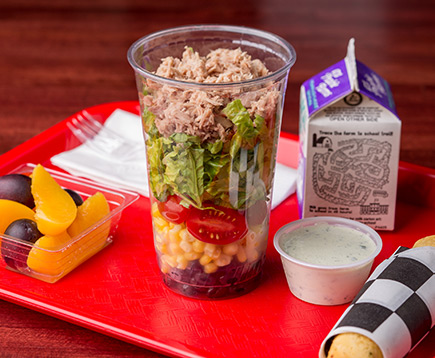
Americans are looking more closely at the foods they eat and many are striving to find more healthy options. In 2012, the Economic Research Service of the USDA estimated that over 43% of American’s food spending was on food eaten away from home.1
While the profile of who is eating away from home the most is changing, all have the same goals in mind: healthy, delicious food. According to the National Restaurant Association survey in 2013 70% of consumers are more likely to visit restaurants that offer healthier options.2
Seafood is an important part of a healthy diet. It is an excellent source of lean, high quality protein which makes it perfect for main dish or appetizer menu items. Many types of seafood are rich in B Vitamins, Vitamin D, and Selenium while being low in saturated fat and a natural source of heart healthy omega-3 fatty acids.
The Dietary Guidelines for Americans and the American Heart Association recommend all Americans eat 2 -3 servings of seafood a week to get the heart protective benefits. The Omega-3 fatty acids in seafood seem to reduce inflammation, helps manage blood pressure, triglyceride and cholesterol levels. Research has shown that people who follow the Mediterranean style diet, which is rich in fruits, vegetables, whole grains and seafood, have lower rates of heart disease, diabetes, certain types of cancer and may support brain health.
Even women who are pregnant or breastfeeding are encouraged to eat 2-3 servings (8-12 ounces) a week of a variety of seafood, including salmon, canned light tuna and shellfish. Studies show there are significant health benefits to eating seafood and that the DHA omega-3 fatty acids, which are naturally found in seafood, are vital for infants’ brain and eye development, making it crucial that expecting and breastfeeding mothers get enough of this important nutrient.
While Americans may be starting to understand the health benefits of a diet rich in seafood, according to the National Fisheries Institute, seafood consumption has dropped 14% from 2006 to 2012 and is at its lowest since 1990.3 The National Oceanic and Atmospheric Administration estimates that Americans eat an average of one serving of seafood a week which is far less than current recommendations.
The reasons for this are varied but many consumers suggest they are hesitant to prepare seafood in their own homes, or don’t feel comfortable buying it. This gives food service operators an added advantage. A recent trend survey by the National Restaurant Association named seafood in 3 of the top 5 main dish trends by chef so it makes sense to take another look at adding additional seafood dishes to menus. 5
Offering a variety of seafood options on your menus using today’s trendy flavors may entice consumers to find new ways to enjoy seafood and supports American’s focus on improving health and wellbeing. Consider adding a seafood bruschetta platter or tuna sliders to your menu or a hearty seafood stew on your winter menu board. Seafood topped salads can be a popular lunch item and grilled salmon, tuna or halibut fillet is always a good choice for dinner menus. The options are endless so be creative and take a dive into seafood this fall!
1 http://www.ers.usda.gov/topics/food-choices-health/food-consumption-demand/food-away-from-home.aspx
2 National Restaurant Association, National Household Survey, 2013
3 https://www.aboutseafood.com/about/about-seafood/statistics/all-statistics
4 http://www.nmfs.noaa.gov/aquaculture/faqs/faq_seafood_health.html#6how
5 National Restaurant Association, What’s hot in 2014 chef survey. http://www.restaurant.org/Downloads/PDFs/News-Research/WhatsHot2015-Results.pdf








